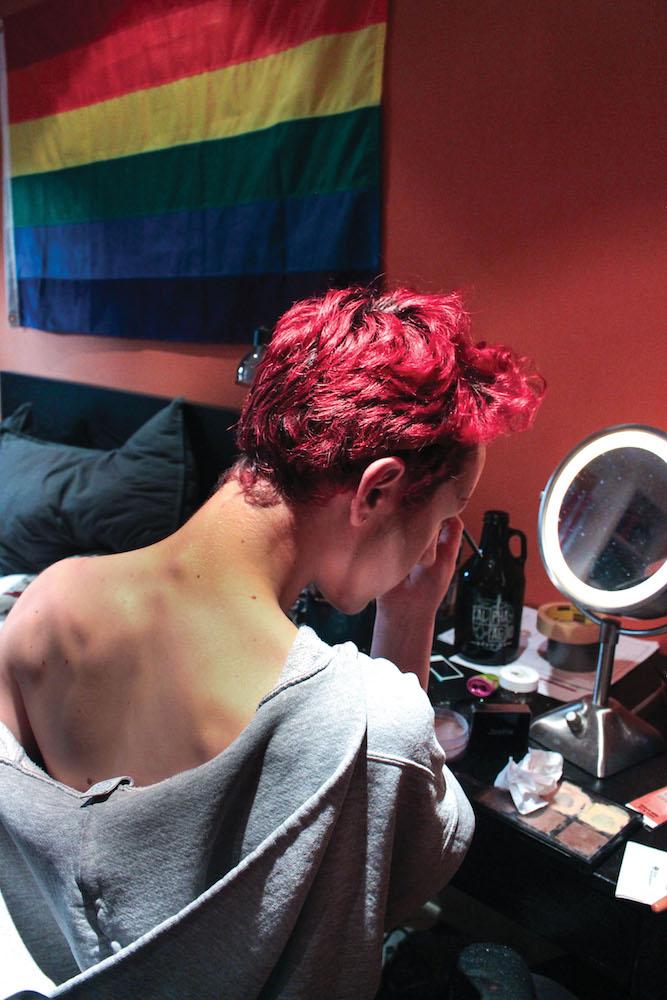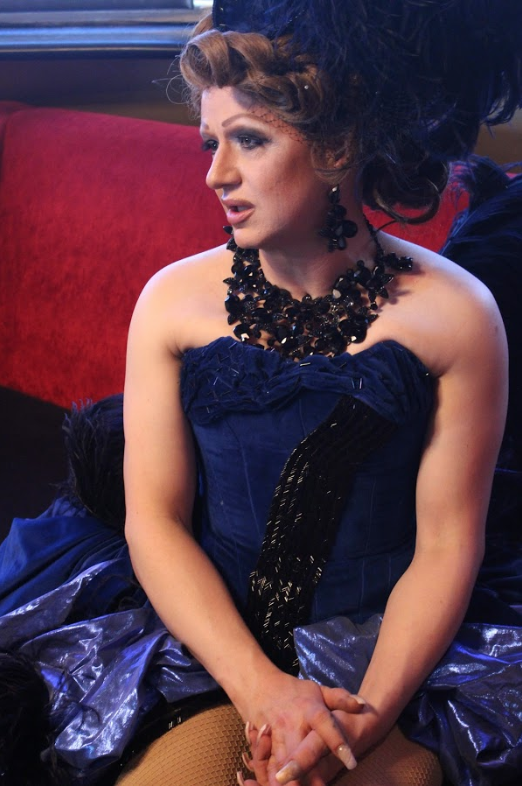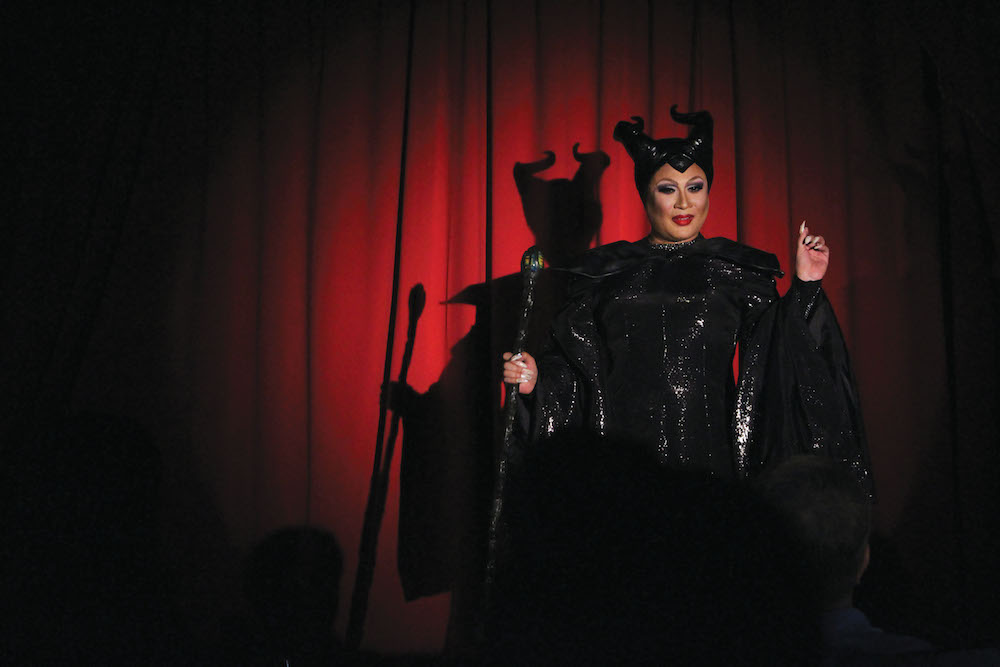Three thousand square inches of black trash bag plastic looked couture on Palo Alto High School sophomore Atticus Scherer, cinched at the waist and topped off with fishnet tights and a pair of five-inch heels.
Strutting glamorously into the center of the floor at Paly’s Homecoming dance, Scherer flaunted his flexibility, sculpted by years of ballet training. By the time he finally landed in a death drop, a move in which the dancer dramatically falls backwards into an outstretched pose on the ground, students had circled around him. They cheered and whooped over the blasting music, many recognizing him as “Waldo” from the sophomore spirit dance. By the end of his short, impromptu performance, it seemed that everyone on the floor knew his name.
What some students remained oblivious to, however, was that many of Scherer’s dance moves are deeply rooted in drag, or the art of satirizing gender. Death drops and split jumps, popularized by “voguing” — a pose-heavy dance style derived from the LGBTQ community — are traditionally moves presented by drag queens to showcase their athleticism and dancing ability while lip syncing.
“Drag” is thought to come from an acronym standing for “Dressed Resembling A Girl,” dating back to Shakespeare’s time where all characters, both male and female, were portrayed by male actors. But outside of theater, drag has long been stigmatized. In 19th century San Francisco, dressing in drag when not performing was a crime, according to San Francisco State University sociology professor Clare Sears, who studies queer and drag history in the city. Even in today’s age of increased acceptance, discrimination still remains.
“A lot of people in the LGBT community have been ostracized and criticized for their gender presentation,” Sears says. “Drag becomes a place to embrace that and play with that and expose the way that all gender is a performance and a construction.”
Scherer has very well embraced his drag character, finding an identity in false eyelashes and dazzling avant-garde outfits.
Sophomore serves looks
Scherer first began experimenting with drag makeup at just 12 years old, though he “started acting very gay” in just second or third grade, he recalls with a laugh.
“The first few times I don’t think anyone had the guts to tell me I looked terrible,” Scherer says. “It [drag makeup] is not easy. Oftentimes it takes an hour just to put on the base foundation, but it’s definitely worth it.”
By “worth it” Scherer doesn’t just mean achieving the goal of appearing and acting like a woman. To him, drag is equal parts aesthetic and psychological, a vehicle for entertainment but also for personal clarity. Although he hasn’t yet come up with a drag name, he views this female persona as a fictional character separate from his real-life identity — an idea that liberates him.
“I have more confidence in drag,” he admits. “Putting on the makeup, the costumes and everything gives you a little bit of protection. … You’re a character. People might judge this person, but when I come out of it, it’s not going to reflect poorly on me. Outside of drag I’m still a human person and I can still live my life however I want.”
This confidence has helped Scherer in other aspects of his life; he’s no stranger to crossing gender-normative lines which don’t appear to phase him. As the co-founder of Paly’s Cosmetology Club, he hopes to inspire other high schoolers, especially boys, who may fear judgment for participating in the female-dominated art of makeup.

And as an aspiring professional ballet dancer, Scherer finds strength — both physical and mental — through the discipline and resilience that being a young male dancer requires. In fact, it was through ballet that Scherer learned his first lesson in standing up to criticism for his drag.
At an evening gala at an annual dance festival, he decided to wear makeup, a dress and heels. Upon seeing the outfit, Scherer says his ballet teacher immediately asked him to take it off, saying that the ensemble was “distracting” and inappropriate for the occasion.
“It was kind of the first time I’d ever felt that it wasn’t okay to be like that [having feminine traits],” Scherer says. “Like, there are girls here in their prom dresses and ball gowns, and I can’t wear a little bit of mascara? … So of course the next night I wore darker eye makeup and higher heels.”
While Scherer can now make light of the incident, he says that at the time it shook his confidence and his relationship with the teacher.
“I was just so angry to the point where I was on the verge of tears,” Scherer says. “We had been really close before, and so I’m kind of scared of people who are close to me, who are older and more mature, shutting me down and saying ‘That’s not okay.’”
Despite this fear, it is clear that Scherer doesn’t plan on letting go of his drag persona anytime soon, and he maintains an unwavering respect for drag as an expressive but demanding art form.
“Drag is not easy and there’s a lot of pain that’s associated with high heels and corsets and tucking,” Scherer says. “It’s uncomfortable. A lot of boys care that like, ‘Oh, it’ll make me seem weak and it’ll make me seem like a woman’ … But I think it actually makes you stronger.”
Still, Scherer was not always as conspicuous about his drag as he is today. Initially, it was just his friends doing makeup on him for fun.
“We would do his makeup and then he’d put on one of my dresses and we’d have a little fashion show,” says sophomore Eve DeMarzo.
As Scherer’s passion flourished, so did hers. DeMarzo is a bio queen, a biological female who adopts the exaggerated feminine character typical of drag queens. She also enjoys doing drag king makeup, adopting the guise of a self-proclaimed “f—boy” character to whom she colloquially refers as Max. DeMarzo hopes to perform in the future, but is apprehensive of the judgment bio queens face.
“A lot of drag queens are really rude to bio queens,” DeMarzo says. “I don’t post photos or perform for anyone but myself and my friends. Some of that is because of the discrimination against female queens, but a lot of it is that I enjoy doing drag for myself, so I don’t want to have to please anyone else.”
“Outside of drag I’m still a human person and I can still live my life however I want.”
— Atticus Scherer, sophomore
In a culture dominated by nightclub performers and a history of criminalization, as well as a persisting cultural stigma, it can be difficult for young queens like Scherer and DeMarzo to find real-life communities and even harder to find places to perform or gain visibility.
“I can do my makeup and have a gay old time doing it, but getting out there is hard,” Scherer says. “It [drag] makes me unique, but I do kind of wish there were just one or two more people that I could share this with, especially at our school.”
Sashaying into SF
Despite Scherer’s feeling of isolation in Palo Alto, nearby at the heart of San Francisco is a vibrant, eclectic breeding ground for drag artists.
This open-mindedness towards LGBTQ culture emanates from the city, spreading across the Bay Area and even to younger generations, including students at Paly.
“People around here might give questioning looks but I think just being in the place that we live, it’s very accepting,” Scherer says of Palo Alto. “They might have questions about it [drag], but they’re not judgmental.”
Displaced three decades in time, but not in place, from Scherer is San Francisco-based drag queen Holotta Tymes who says the city has been a historic beacon for drag performers.
“San Francisco is much more progressive,” Tymes says. “It is definitely on the forefront of the creativity that comes from drag and the performance art aspect of it.”
On stage, Tymes seems to exude an impenetrable self-confidence, projecting her singing to the entire venue and accenting high notes as she caricatures the female voice. Yet, as she sits down to talk with us post-performance, her facial features soften. Her voice shifts in timbre as she reminisces about her experiences.
Tymes launched her performance career in traditional musical theater. But with her small stature and more feminine traits, Tymes says that as she grew older, she increasingly struggled to find jobs within the confined gender-normative archetypes of mainstream theater.
“Not getting booked because I was too short or not masculine enough … it f—ed with me,” she says.
At last, Tymes was cast in the musical “La Cage Aux Folles” where she performed in drag, exposing her to a much more fluid and dynamic art form where she could sculpt a female character of her own rather than having to fit into an established male one. She was then cast in Finocchio’s, a world-famous female impersonation show in San Francisco where she personified celebrities such as Liza Minelli and Reba McEntire.
Now, Tymes performs in shows across the country — among them, “Sundays a Drag,” where she guest emcees alongside drag queen and fellow emcee Donna Sachet. Hosted at the world-famous Starlight Room, the show has been running for 13 years, a mere blink in the vast history of drag in the Bay Area.
Its uniqueness lies in its accessibility — as one of the only drag shows in San Francisco open to audiences under 21, it prides itself in bringing drag to all ages. “Sunday’s a Drag” strives to reach aspiring queens like Scherer, who looks up to successful queens similar to Tymes and Sachet.
“The audience is probably half in-town, half traveling people, half straight, half gay, half women, half men, half young, half old,” Sachet says.
This diversity and mainstream quality of drag characteristic of San Francisco was largely a novelty to Sachet, who hails from South Carolina. Growing up, she idolized classic black-and-white movie stars such as Elizabeth Taylor and Marilyn Monroe. Gradually, she made her pilgrimage to San Francisco, shedding her traditionally masculine layers in favor of feather boas and ornate dresses.

In contrast to Scherer, Sachet sees her drag as an extension of her male persona rather than a disembodied character — so much so that in many cases, she prefers not to use her given name, known in the drag community as a “boy name,” and dresses in drag for outside events.
“A lot of people put drag on, I let drag out,” Sachet says. “I always had certain feminine traits, more delicate and theatrical. And when I found I could express that fully as a drag queen, it was like I struck gold.”
However, Sachet, who lived in the Deep South for much of her life, has not always been able to freely express this side of herself. She recalls a particularly vivid moment when she dressed in drag for a pride parade in Mobile, Alabama. Protesters surrounded, yelling demeaning slurs. Suddenly, Sachet started singing the national anthem and the protesters, taken aback, lowered their bullhorns and put their hands over their hearts, united for a brief instant by their humanity.
“For a moment, we were all Americans and we had more in common,” Sachet says. “We live in a bubble in San Francisco, but I’ve experienced my share of discrimination and hatred and ridicule. It’s still all around us.”
Tymes echoes this sentiment, adding that she wishes hatred everywhere would fade and give way to the younger, more accepting generation for which San Francisco is already paving the path.
“I hope that we stop stereotyping people into feminine or masculine,” Tymes says. “I hope that we stop labels. The older I’ve gotten, the more I’ve realized that it just doesn’t matter. Just let people live.”
Spilling the tea on TV
Discrimination is ever-present in the drag community, and the media, although striving to improve inclusivity, is no different.
The comment section of the YouTube trailer to “Super Drags” is surely one of the most intense places on the Internet. The series, which premiered on Netflix on Nov. 9, portrays men in drag as superheroes who protect the LGBTQ community from crime. The responses from viewers couldn’t be more varying — some excited, some harshly disapproving.
And yet drag has been emerging in the mainstream media for a while, slowly gaining traction and capturing broader audiences with its eccentric, often humorous appeal. Perhaps most popular is “RuPaul’s Drag Race” — a reality TV show in which 13 queens compete for the title of America’s Next Drag Superstar.
Senior Derek Zhou, an avid fan of “Drag Race” describes the show as “fun.” Nevertheless, he recognizes the issues of appropriation and commercialization the show has brought up. For instance, “Drag Race” has brought drag vernacular into pop culture slang; most use these expressions, which range from “spilling the tea” to “realness,” without knowing their origins in the underground Latinx and black drag ball scene of the early 20th century.
“Drag culture has become sort of this thing of its own that tends to forget where it actually came from and people take credit for it who didn’t start it,” Zhou says.
Tymes, having performed both in a time when drag was largely unknown and now, when drag is fairly normalized, concedes that there are downsides to “Drag Race,” as it has stifled support for local drag performances.
“The minute you are able to attach that drag race name to your persona, you’re booked across the country,” she says. “There are so many talented performers that deserve the same accolades, and I wish there was a way to get them that work without having to be on that show.”
Still, the show has positively influenced many aspiring queens, including Scherer, who, despite not having a real-life drag community, has found one on the web. He has admittedly watched all 10 seasons of “Drag Race” (as well as all three seasons of “RuPaul’s Drag Race: All Stars”), and looks up to many of the queens for their makeup and performance styles.
“It [“Drag Race”] is getting the drag community out there and boosting acceptance for those who identify differently,” he says.
In fact, one of Scherer’s aspirations as a drag queen is to compete on the show. But regardless of whether he becomes the next “Rupaul’s All Star,” he says, he’s found a long-term passion in drag and hopes to continue, whether it be experimenting with dramatic makeup, finding the perfect drag name, voguing and lip syncing or creating fierce outfits out of unconventional materials.
“It’ll always be a part of my life no matter what I’m doing,” Scherer says. “When I’m in drag I feel great and I feel like I look great no matter what I’m wearing. It makes me feel alive.” v




![MIRROR MIRROR Sophomore Atticus Scherer gets ready for the Homecoming dance in a dress made from a trash bag. Scherer has been experimenting with drag makeup since he was 12 years old. "It [drag] makes me unique," Scherer says.](https://verdemagazine.com/wp-content/uploads/2018/11/IMG_3954-1.jpg)